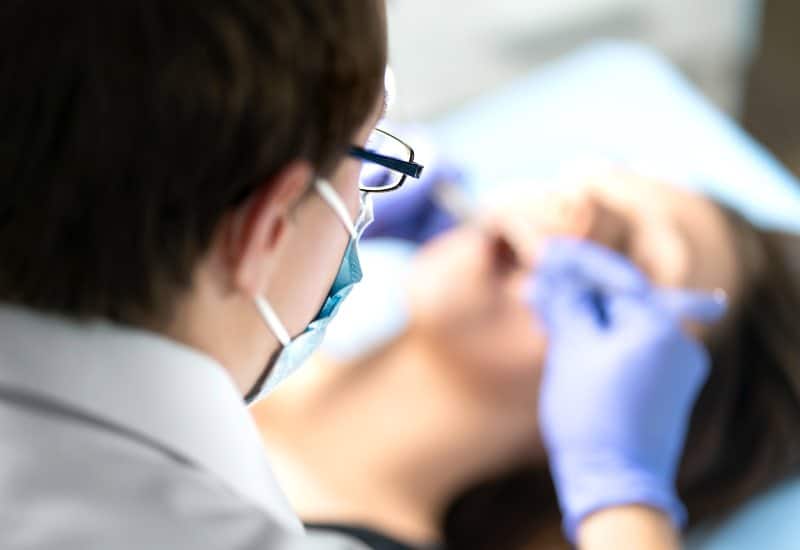Dry Socket: What It Is, Symptoms, & Treatments

About Dry Socket Symptoms and Treatments in Central Texas
Everything You Need To Know About Dry Socket
Wisdom teeth removal is a common procedure that, when cared for properly, offers limited side effects. However, in some cases, patients may develop dry socket which causes a great deal of discomfort. Austin Oral Surgery is here to explain everything you need to know about dry socket, from symptoms to treatments and beyond.
Understanding Dry Socket
Dry socket, also known as alveolar osteitis, is a condition that may occur following a tooth extraction, particularly wisdom teeth removal. This condition arises when the blood clot fails to develop over the extraction site, or when it becomes dislodged or dissolves prior to the wound healing, exposing the bone and nerve endings.
The Importance of the Healing Blood Clot
Following a tooth extraction, it’s important that a blood clot is formed to promote the healing process. The blood clot serves as a barrier that shields the bone and nerve endings at the extraction site while also encouraging the growth of new bone and soft tissue.
The Symptoms of Dry Socket
The most common symptom patients notice is worsening pain and abnormal discomfort in the days following their wisdom teeth removal procedure when they have developed dry socket. However, you may also notice one or more of the following:
- A tender feeling
- A bad taste
- Foul breath
Identifying Dry Socket
After wisdom teeth removal, the hole left behind should develop a blood clot that resembles a scab. When a patient develops dry socket, this blood clot does not develop or is lost and often causes severe pain. It’s important to contact your doctor if you suspect you have dry socket.
The Causes of Dry Socket
The exact cause of dry socket is hard to define. However, there are specific issues that contribute to dry socket, such as bacterial contamination in the extraction site or trauma that has impacted the surgical area due to a challenging extraction.
Why Dry Sockets Cause Pain
When exposed the bone and nerve endings at the extraction site can radiate pain through your jaw and up the side of your face. When the dry socket becomes affected by food debris and other bacteria it can become inflamed resulting in further pain and discomfort.
Dry Socket Risk Factors
There are several things to avoid to reduce the risk of developing dry socket, including:
- Smoking and the use of tobacco
- Oral contraceptives
- Improper oral hygiene
Complications Associated With Dry Socket
In most cases, dry socket does not result in severe complications or infections. However, there is still a potential for complications, such as prolonged healing time or an infection in the extraction site that progresses to the bone.
Pre-Surgery Care for Dry Socket
Prior to undergoing wisdom teeth removal, it’s important that you feel comfortable and informed. During your consultation with your oral surgeon, you may inquire about any medications or supplements you take to ensure they will not affect the procedure. You may also ask for specific instructions on how to prepare for your wisdom teeth removal.
How to Prevent Dry Socket
There are several measures you may take to reduce the risk of dry socket. It is recommended to avoid smoking for at least 72 hours after your procedure. Furthermore, it’s recommended to not drink through a straw, to avoid hot or carbonated drinks, and to carefully follow the post-operative guidelines given by your oral surgeon.
Healing Wisdom Teeth Dry Socket
Wisdom teeth dry socket may heal without professional intervention. However, the symptoms associated with dry socket typically cause discomfort that leads most patients to seek professional assistance and dry socket treatment to ease the aches and pains faster.
Wisdom Teeth Dry Socket Treatment
Dry socket treatment is primarily designed to alleviate discomfort. Your oral surgeon at Austin Oral Surgery may recommend one or more of the following:
- Salt water mouth rinses
- Medicated gauze in the extraction site
- Over-the-counter pain relief or anti-inflammatories
- Ice-packs
Additional Healing
Your oral surgeon may offer you several ways to promote optimal healing while eliminating the risk of dry socket. You may ask them about antibacterial mouthwash, oral antibiotics, antiseptic treatments, or medicated dressings that help protect the extraction site following your wisdom teeth removal.
Post-Surgery Care
To deter dry socket and promote faster healing for your extraction site following wisdom teeth removal, it’s important to follow the at-home care guide given by your oral surgeon. It’s best to refrain from physical activity for the first day and to ice your face and drink lots of water while sticking to only soft foods.
When to See Your Oral Surgeon
It is normal to experience a moderate degree of discomfort following wisdom teeth removal. If you begin to notice that the pain levels are increasing or if you begin developing new symptoms, it’s important to contact your oral surgeon right away.
Talk to an Expert About Wisdom Teeth Removal Today
Austin Oral Surgery is here to help you understand wisdom teeth removal, dry socket, and all the information associated with this type of dental procedure. To learn more or to schedule a consultation, contact our friendly professionals today.


